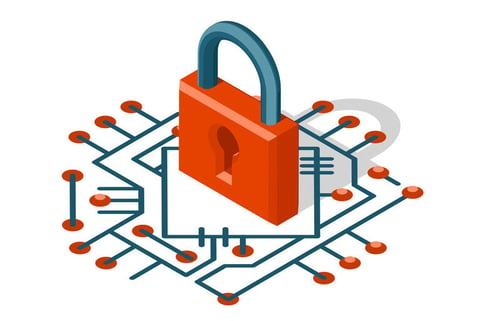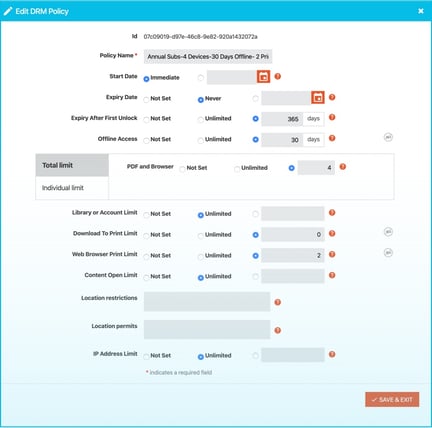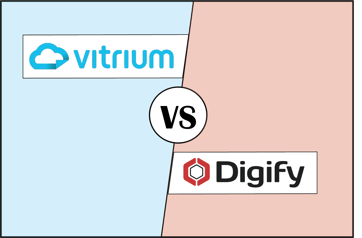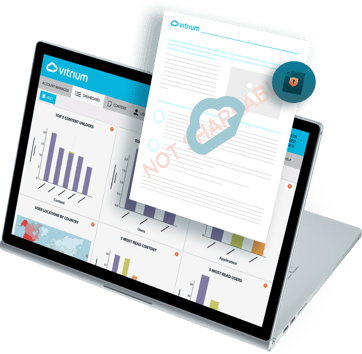If you wonder: How do I protect my content? How do I choose DRM software? How can I leverage DRM protection? We've got the answers for you.
Flexible DRM Policies and Control
There is a general misunderstanding when it comes to digital rights management (DRM). Most people believe that because it enforces strict policies it is highly restrictive and, as a result, it significantly tampers with ease of use, which in turn hinders user experience.
It is important, initially, to understand that the strictness of the policies enforced on a particular file or set of files will depend entirely on you, the content provider. Additionally, it is worth noting that strict policies do not equate to difficulty when accessing or engaging with content. The fact that you set somewhat strict or restrictive policies does not mean your authorized users will have a harder time accessing materials you provide. It is possible to enforce strict policies on content that is, perhaps, more sensitive, and still be able to offer a good user experience, maintaining a high degree of security while ensuring ease of use.
 Different Degrees of Security for Specific Content
Different Degrees of Security for Specific Content
There are different types of content that make up your intellectual property and that you license or sell to your clients. These materials are assets that are worth protecting, since they provide a source of revenue for your company, and consequently are at high risk of being copied or shared without permission. Failing to protect your content can result in malicious actors accessing it and sharing, copying or tampering with it.
However, as a company that creates, produces, or distributes valuable material there are degrees or levels of security you can adhere to depending on the sensitivity of the content you are protecting. Course materials, eBooks, educational content and training materials might need broader, less strict policies; whereas market reports, standards documents, board materials and trade secrets are files that contain very sensitive, often-times confidential information, will require more strict policies.
Moreover, applying different DRM policies for different users, some policies being more restrictive than others, can allow you to use this within a subscription-based pricing system where you sell your content at different price-points and change the level of DRM control for each subscription tier. Content that is deemed more exclusive will, naturally, require a higher degree of protection and therefore be more expensive to acquire or access. Or the opposite can be true: the higher-priced subscription offers users the more lenient protection measures and DRM controls. For example, at the lower-price subscription level, users are restricted to only viewing their content on 1 device and they are not allowed to print the content, whereas at the higher-priced subscription level, users are allowed to view their content on multiple devices and allowed to print.
Implementing a DRM strategy that has varying degrees of security allows you to, for one, ensure your sensitive content is protected accordingly, while giving you the opportunity to position your product as a subscription rather than a single “file” or set of “files,” which will no doubt be beneficial for your revenue.

What Kind of DRM Policies Should You Use?
Depending on the content you wish to protect, and how you want to allow your authorized users to access it and engage with it, you will benefit from different kinds of DRM policies. First, it is important to note that, with a quality DRM solution, you can choose to set digital rights management policies at different levels. Setting policies at different levels provides the opportunity to have control over your content while still providing a pleasant user experience for your customers.

Namely, you can have policies at the content level, which control the files you are providing; you can have policies at the user and/or group level, which control how each user or group of users can access the content they have paid for; and, finally, you can have policies at the folder level, which control the content that is located in a specific folder within your portal. Making the most of these policies gives you control over your content and how it is accessed, restricting certain files for certain users or groups of users,
and making others more broadly available for those that are,
perhaps, paying for a more exclusive subscription.
Once you have decided on which levels you will apply your DRM rules you must choose which policies you will enforce. The kind of policies you decide to use will provide different degrees of ease-of-use, or “freedom,” for your customers. With a quality digital rights management solution, there are many kinds of rules you can apply to your content so that it is thoroughly protected. You can set expiration dates, which limit the amount of time content is available for a certain user or groups of users. Device limits and browser limits, on the other hand, will limit a user’s ability to access content from several devices and several browsers. Depending on the subscription they have, for example, you can choose to allow access from multiple devices or a single one.
Another useful tool to keep in your arsenal are watermark settings, these are a great way to deter individuals from sharing or copying your content, without hindering user experience. You can choose from static watermarks, which are text-only, and serve as a stamp on your content which lets users know copying and sharing is illegal; or dynamic watermarks, which are user-specific, which can include the name of the person who the content has been licensed to, as well as their IP address, and other details.
 Finally, you can control offline access and printing. Granting offline access allows you to permit certain users to have access to the content they have licensed even without an internet connection, they will be able to see their content on a specific web browser for a certain amount of time, regardless of being offline. Additionally, you can choose to allow printing or not, and control how it is done. If you do allow printing, you can determine how many times a file can be printed, and who has permission to print.
Finally, you can control offline access and printing. Granting offline access allows you to permit certain users to have access to the content they have licensed even without an internet connection, they will be able to see their content on a specific web browser for a certain amount of time, regardless of being offline. Additionally, you can choose to allow printing or not, and control how it is done. If you do allow printing, you can determine how many times a file can be printed, and who has permission to print.
Protect Your Content, Increase Your Revenue
Deciding on which levels to set your policies, and choosing among these DRM settings will determine how your content is protected and how easily it can be accessed by your users. Having broader, less restrictive policies in place, provides looser security but easier access to all your users. Having stricter policies, however, provides a high degree of security for your content, and does not need to suppose a cumbersome process for your users.
Again, this gives you the chance to not only protect your content but also position it as a quality product and sell it at different price-points. By having varying policies for different “subscriptions,” you can offer greater ease of use while increasing your revenue. In this regard, choosing a quality DRM system, as is Vitrium Security, at one enables you to protect your content and secure, as well as increase, your revenue.
By signing up with Vitrium Security, a simple, hassle-free DRM solution, your content can be protected in as little as one day. Learn more about our software, click here to request a free demo!





